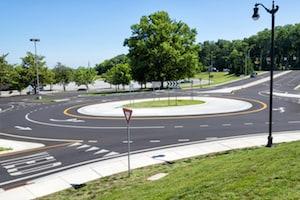Around and Round We go

Roundabouts were established to help keep traffic flowing and improve safety. They are a type of small, one-way circular intersection and drivers travel at slower speeds. They are not rotaries or traffic circles. In a roundabout, there are no lane changes that occur, just vehicles making “crossing movements” in and out of the roundabout.
According to the Federal Highway Administration (FHWA) roundabouts are a proven safety countermeasure that can reduce fatal and injury crashes between 60-87 percent. Roundabouts have also been effective in managing speed and transitioning traffic from high speeds to low speed zones. Roundabouts have better operational performances from stop lights and have fewer delays. They have also improved pedestrian and cyclist safety.
Roundabouts are located on many U.S. and state highways, local roads, and county roads. Roundabouts can be found in new residential subdivisions, near or on school property, at major interchanges or gateways, at intersections, and often with commercial developments. Florida has more than 20 roundabouts on state highway systems and 300 roundabouts on local roads according to the Florida Department of Transportation (FDOT).
With all these roundabouts and with all the benefits and improved safety features, why do roundabouts cause so much driver confusion? Well, many drivers say they just don’t know what to do. They understand what to do at a stop sign or at a traffic light, but at a roundabout, that’s a whole different story. Some drivers were taught about roundabouts when they learned to drive, but it often wasn’t something stressed or they don’t remember because it was so long ago. Many roundabouts were built in the last 10 years and may be new to those on the road. Then you also have drivers that are just not paying attention to the roadway (distracted driving or texting while driving) or they are driving recklessly.
Common issues that occur in roundabouts are drivers who fail to yield to other drivers, drivers who change lanes, and drivers who just stop in the circle and impede the traffic flow.
So how does a driver maneuver a roundabout? In Florida, FDOT provides the following user tips:
- Determine and know where you want to go.
- Treat an approaching roundabout as you would a four-way intersection.
- Reduce your speed to 10-15 mph and stay to the right of the splitter island.
- Be vigilant and watch for pedestrians and cyclists and be prepared to share the roadway or yield or wait for walkers in crosswalks.
- Yield to any traffic already in the roundabout. Enter when you have a safe gap in traffic.
- Do not turn left at the splitter Island.
- Once you are safely in the roundabout, keep moving. Do not stop, except to avoid an accident. Once you are in the roundabout, you have right-of-way over entering traffic.
- Drive in a counter-clockwise direction.
- Look for your exit, use your right turn signal to indicate your exit and safety exit the roundabout.
- Continue to be vigilant, watching for pedestrians and bicyclists as you exit the roundabout.
- Most important, if you should miss your exit, simply ride around the roundabout again to your desired exit.
And finally, when you are in or around a roundabout stay alert to help prevent or avoid an accident.





